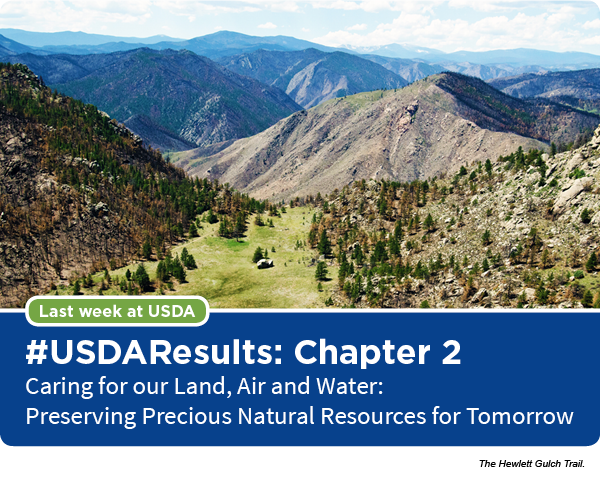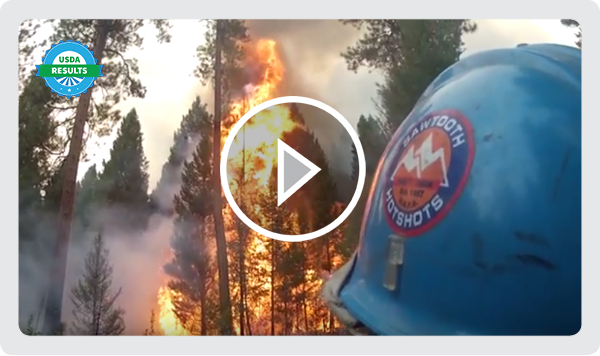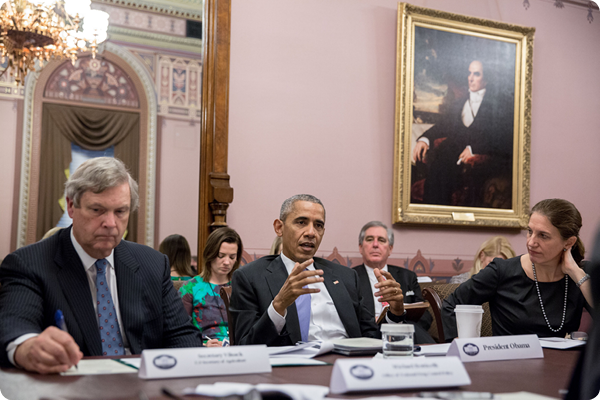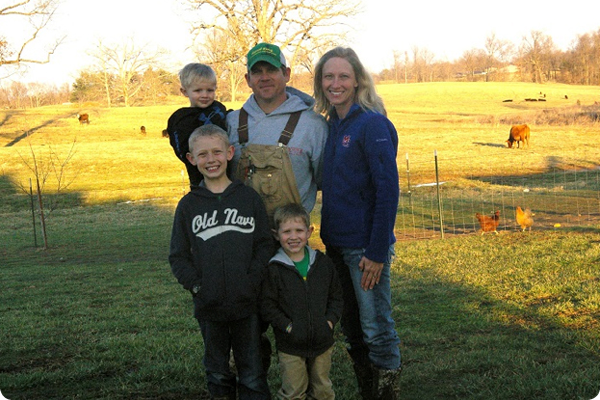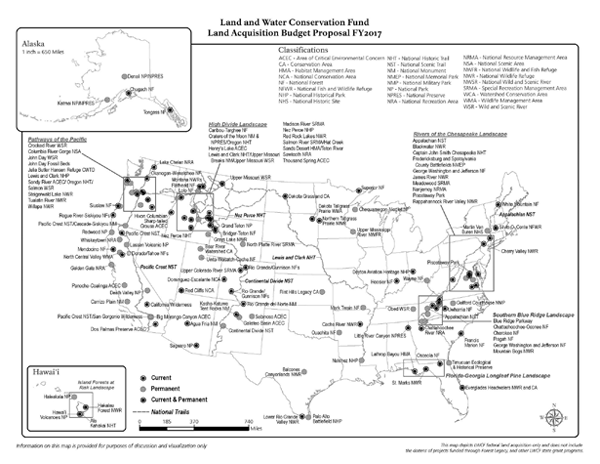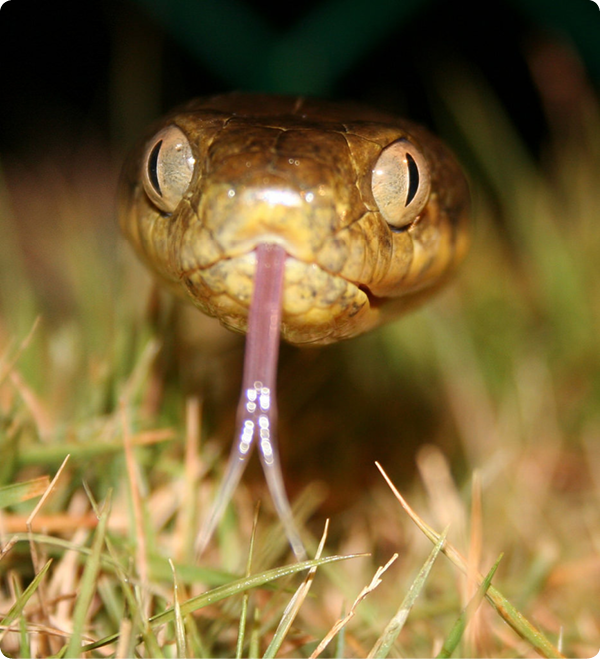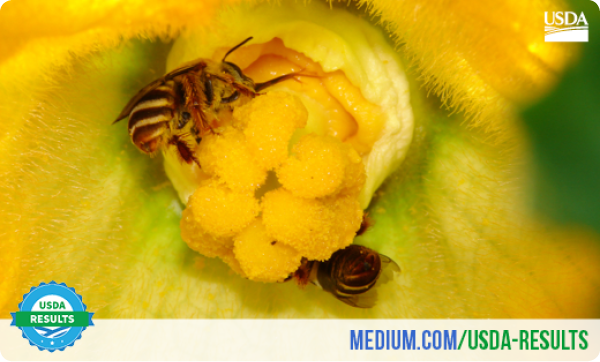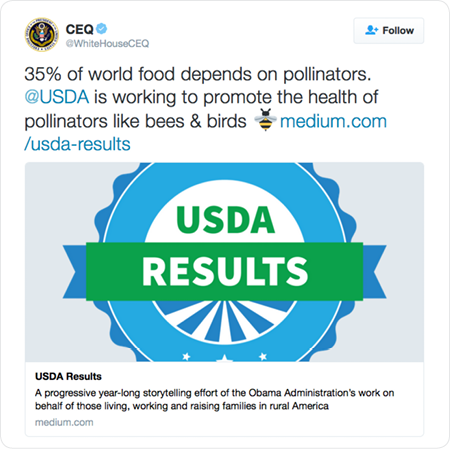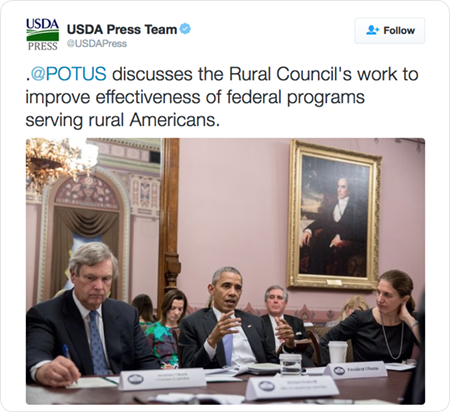Having trouble viewing this email? View it as a Web page.

President Obama participated in the White House Rural Council led by Secretary Vilsack where he talked about key aspects of rural America and ways to better target federal resources to help rural communities facing a number of challenges.
Investing in Our Public Lands: The President’s Proposal to Fully Fund the Land and Water Conservation Fund.
This month USDA highlights some of the important partnerships that work with us to care for our land, air and water. The work stretches into areas and takes USDA employees to places you wouldn’t suspect. For example, the damage wreaked by invasive brown tree snakes on Guam.
Be sure to take a look at how historic investments from USDA over seven years have supported our farmers, ranchers, and growers, yielding positive results for American agriculture and for the American people: https://medium.com/usda-results.
USDA Celebrates a Record of Conservation Successes Throughout the last seven years, the USDA Forest Service and Natural Resources Conservation Service have made great strides in conserving private working lands and our public lands for future generations. We have pioneered approaches to conservation that use incentives and partnerships to work with landowners across property boundaries and conserve watersheds, wildlife and large landscapes. What’s more, USDA is demonstrating that conserving our natural resources creates economic opportunities for rural communities across the country.
At the beginning of this year, we launched a year-long reflection on USDA-wide results achieved over the course of this Administration. This week begins a month-long focus on seven years of USDA accomplishments to preserve our natural resources for tomorrow’s generations – accomplishments that have only been made possible with the hard work of our staff at USDA and the support of our steadfast partners.
At USDA this month, we’re taking some time to focus on the work of farmers, ranchers and forest landowners to conserve our planet and our resources for the future. They know, like we do, that cleaner air, water, soil and habitat are not only good for our planet, but also contribute to healthy and productive working farmlands.
The USDA Agricultural Marketing Service’s National Organic Program (NOP) is continuing to launch new resources resulting from our Sound and Sensible Initiative, which is making organic certification more accessible, affordable, and attainable. Today, we are launching resources that help those who help others – guides and resources that help organizations reach out to and educate potential organic farmers. These resources were produced by our partners in the organic community, all of whom have on-the-ground experience teaching producers about the organic option. Over 50 years ago, a visionary Congress established an innovative program to bring communities together to invest in open spaces and recreational opportunities that are an essential part of our nation’s heritage and economy. Since then, the highly successful Land and Water Conservation Fund has helped to protect working forests and ranches, preserve our public lands — parks, refuges, forests, rivers, lakes and wildlife habitats — and provide access to outdoor recreation across the nation for use and enjoyment by all Americans.
2016 has been named “International Year of the Pulses” by the General Assembly of the United Nations (UN). The goal of the initiative is to educate consumers about the nutritional and other benefits of eating pulse crops, as well as to marshal the capabilities of agricultural research organizations around the world in developing new, improved varieties that will help further global food security and sustainable agriculture.
Seeing President Obama’s fiscal year 2017 budget proposal and the strong commitment it makes to agricultural research reminds me of Dr. Consuelo De Moraes. As a university researcher and panel manager of the National Research Initiative (NRI) competitive grants program, I called Dr. De Moraes in 2002 to inform her that USDA was going to fund her research proposal on determining how plants defend themselves against insects, so farmers could exploit the same as a means to control pests.
“Nothing motivates me quite like being told I can’t do something. They told me no-till doesn’t work here, and you’re not supposed to be able to grow any type of canola. Well, look around. Here we are.” When Douglas Poole speaks, you can hear the passion in his voice for healthy soil and how it has helped his farm. Poole wasn’t always a soil health proponent; he used to be an accountant.
We’re all fortunate to live in a country that has one of the most productive and efficient food production systems in the world. The United States produces over 430 billion pounds of food each year. However, nearly a third of the food produced by farmers goes uneaten, representing $161.6 billion. That’s enough food waste to fill 44 Sears Towers every year. To meet this challenge, USDA scientists are developing innovative programs and using cutting-edge research to reduce food waste on the farm, on supermarket shelves, and in the home.
On January 15, 1967, the Green Bay Packers faced off against the Kansas City Chiefs in the very first Super Bowl. On that day, few of the estimated 51 million fans gathered around their television sets realized the profound impact the Super Bowl would have on chicken consumption in the United States. The Packers won the game 35-10, but ultimately the real winner was chicken – particularly wings.
This month USDA highlights some of the important partnerships that work with us to care for our land, air and water. The work stretches into areas and takes USDA employees to places you wouldn’t suspect. For example, the damage wreaked by invasive brown tree snakes on Guam is hard to imagine. Drought is inevitable, a recurring natural event – or series of events – that can be felt over a season or a severe, longer lasting natural event that has social and economic consequences. But how land managers prepare for or react at any stage of a drought in today’s world with the increasing effects of climate change and the information they use is the focus of a new report by the U.S. Forest Service, Effects of Drought on Forests and Rangelands in the United States: A Comprehensive Science Synthesis.
Drought’s harm to forests more severe than feared, study finds (San Francisco Chronicle) Worsening drought conditions may be doing more damage to forests in California and throughout the West than their ecosystems can handle, causing a spiral of death that could have a devastating impact, a U.S. Forest Service study concluded Monday.
Throughout the years, it is well known that during times of drought, forests and vegetation can bounce back easily. This may not be always the case since they may take longer to recuperate, a new report suggests. The U.S. Forest Service released a report on the effects of drought on forests and rangelands in the country.
The federal government’s largest conservation program — by acres affected — plans to add an estimated 10 million more acres to the rolls through September. Agriculture Secretary Tom Vilsack said Thursday that $150 million in funding for the additional acres is available for agricultural producers through the Conservation Stewardship Program.
U.S. Agriculture Secretary Tom Vilsack announced that $150 million in funding is available for agricultural producers through the Conservation Stewardship Program (CSP), USDA’s largest conservation program that helps producers voluntarily improve the health and productivity of private and tribal working lands. USDA’s Natural Resources Conservation Service (NRCS) plans to add an estimated 10 million acres to the rolls of CSP during fiscal 2016.
Secretary of Agriculture Tom Vilsack announced Wednesday that more than $30.1 million in competitive grants have been awarded to fund 80 research projects to improve food safety, reduce antibiotic resistance in food and increase the resilience of plants in the face of climate change.
USDA announced Wednesday it will grant $30.1 million to food safety and plant health research that the department says is essential to bolstering America's farm economy and attracting new farmers to the sector.
The U.S. Forest Service has released a new report that provides a national assessment of peer-reviewed scientific research on the impacts of drought on U.S. forests and rangelands.
Actuality: This Month USDA Is Spotlighting Conservation Efforts Broadcast Date: Thu, February 4, 2016 Agriculture Secretary Tom Vilsack saying that this month USDA is spotlighting the successes of its conservation programs.
Broadcast Date: Thu, February 4, 2016 If you are a farmer or landowner who has thought about taking part in the Conservation Stewardship Program, now is a good time to act on that thought. (Gary Crawford and Sec'y Tom Vilsack)
Broadcast Date: Thu, February 4, 2016 Many of the Trans Pacific Partnership member nations believe somewhere in the future one of their major trading partners, China, could enter into this agreement. (Rod Bain. US Trade Representative Michael Froman. Australian Trade Minister Andrew Robb)
Broadcast Date: Thu, February 4, 2016 Agriculture Secretary Tom Vilsack saying that the Conservation Stewardship Program is part of what is becoming a more regional approach to conservation.
Broadcast Date: Thu, February 4, 2016 El Nino backed storms continue to reduce the footprint of drought in the nation as a whole, and particularly in drought areas like the Far West. (Rod Bain and USDA meteorologist, Brad Rippey)
Broadcast Date: Thu, February 4, 2016 Wide ranging winter storms could provide the Western mountain ranges their best snowpack totals in several years. (Rod Bain and USDA meteorologist, Brad Rippey)
Broadcast Date: Wed, February 3, 2016 The signing of the Trans Pacific Partnership trade agreement means the deal is one step closer to reaching ambitious goals set out by member nations. (Rod Bain and US Trade Representative Michael Froman)
Broadcast Date: Wed, February 3, 2016 US Trade Representative Michael Froman explains what is next for the TransPacific Partnership trade agreement in terms of US congressional ratification.
Broadcast Date: Wed, February 3, 2016 The President plans on asking Congress for a boost in money for agricultural research. (Gary Crawford, Dr. John Holdren and Sec'y Tom Vilsack)
Broadcast Date: Wed, February 3, 2016 Dr. John Holdren, Director of the White House Office of Science and Technology Policy, telling reporters that the President's FY 2017 budget proposal will include strong program to combat antimicrobial resistance.
Broadcast Date: Mon, February 1, 2016 A new Forest Service report offers a look at how drought might continue to impact our nation's forests and rangelands in the future. (Rod Bain and Chief Tom Tidwell)
|

